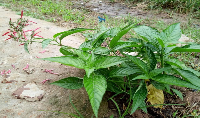Hepato-protective potentials of aqueous, chloroform and methanol leaf extracts of Whitfieldia lateritia on 2, 4-dinitrophenylhydrazine-induced anaemia in rats
Main Article Content
Abstract
This study aimed at investigating the hepato-protective potentials of the aqueous, chloroform and methanol leaf extracts of Whitfieldia lateritia on 2, 4-dinitrophenylhydrazine (2,4-DNPH)-induced anaemia in rats. The toxicity study, quantitative phytochemical screening, total and direct bilirubin concentrations, mean protein, albumin and globulin concentrations, as well as mean liver marker enzymes activities (ALT, AST and ALP) were carried out using standard procedures. Thirty-six wistar rats were grouped into six (n =6). Group I: normal control; Group II: negative control; Group III: administered 0.6 ml/kg body weight (b.w) of Astifer (standard Haematinic); Group IV to VI were administered 400 mg/kg b. w. of the aqueous, chloroform and methanol leaf extracts, respectively. Induction of anaemia was achieved in the test groups (II-VI) by administration of 2, 4-dinitrophenylhydrazine (20 mg/kg b.w.) once daily for seven days. Administration of extracts commenced subsequently and lasted for 21 days. Animals were sacrificed on the 22nd day and blood collected for laboratory analysis. ALT, AST and ALP activities of group II anaemic rats showed significant (P < 0.05) reduction compared with normal control rats. Group III rats showed significant (P < 0.05) increase in ALT, AST and ALP activities compared with group II anaemic rats. Group IV rats showed significant (P < 0.05) increase in ALT and AST activity compared with group III rats. The total bilirubin concentration of group II rats was non-significantly (P > 0.05) higher compared with the normal control rats. Groups IV and VI rats showed non-significant (P > 0.05) reduction in total bilirubin concentration compared with group V rats. In conclusion, W. lateritia leaf has beneficial hepato-protective properties in Wistar rats at therapeutic dose that supports its use in the treatment of hepatic diseases.
Downloads
Article Details

This work is licensed under a Creative Commons Attribution-NonCommercial-NoDerivatives 4.0 International License.
References
Aja, P. M., Okorie, U. C., Ozougwu, U. E. O., Onya-Mmaghiri, E. A., Agu, K. A. and Nweke, K. A. (2016). Phytochemical and gas chromatography mass spectrometric(GC –MS) analysis of Whitfieldia lateritialeaf. Africa Journal of Basic and Applied Science,8 (1): 41-54.
A.O.A.C (2010). Official methods of analysis, association of official analytical Chemists. 18th Edition, Washington DC, USA. Pp. 200-210.
Barbosa-Ferreira, M., Dagli, M. L., Mairoka, P. C. and Gornak, S. L. (2005). Sub-acute intoxication by Senna occidentalis seeds in rats. Food Chemistry and Toxicology, 43:497-503.
Bumbari, W. E., Anula, P. D., Souwani, T. S. and Nimane, J. R. (2009). Evergreenplantation of Whitfieldia lateritia in East Africa. Journal of Environmental Agriculture and Food Chemistry,8(3): 396 – 399.
Chandra, R. K. (1990). Micronutrients and Immune Functions: An Overview. Annual New York Academy of Science,587:9-16.
Cowan, M. M. (1999). Plant products andantimicrobial Agents. American Society of Microbiology, 12: 564-582.
De-weerd, N. A., Samarajiwa, S. A. and Hertzog, P. J. (2007). “Type 1 inferon receptors: biochemistry and biological functions. Journal of Biological Chemistry, 282(28): 20053-20057.
Edeoga, H. O., Okwu, D. E. and Mbaebie, B. O.(2005). Phytochemical constituents of some Nigerian medicinal plants. African Journal of Biotechnology,4(7) 685-688.
Eleje, A. E. and Akujobi, C. O. (2011). Effects of secondary metabolites of Garcinia kolaon the microbial spoilage of Cajanuscajan extract. International Journal of Tropical Agricultural Food Systems, 5(1):8-14.
Harborne, J. B. (1993). Phytochemistry. Academic Press London, pp. 89-131. Kayode, A. A. and Kayode, O. T. (2011). Some medicinal values of Telfaria occidentalis.American Journal of Biochemistry and Molecular Biology,1 (1): 30-38.
Krishna, H. P., Mahalingan, K., Sandeep, S., Reshma, L. and Amritha, V. (2014).Antioxidant properties of various fruits, herbs, spices and vegetables: A review. World Journal Pharmacy and Pharmaceutical Sciences, 3 (2): 1101-1109.
Lorke, D. (1983) A new approach to practical acute toxicity testing. Archives of Toxicology, 54:275-87.
Mauro, P., Renze, B. and Wouter, W. (2006).Enzymes, Text book of clinical chemistry and molecular diagnostics. 4th edition, Elsevier pp. 604-616.
Mbuh, F. A., Galadima, M. and Ogbadu, L. (2003). The rate of co-infection with Malaria parasite and Salmonella typhi, Annals of Medicine, 2: 64-67.
Naom, J. O., Cock, H. P. and Perptera, C. L. (2008). Serum devoid of albumin are called albuminemia. American Journal ofMedicine, 13(2): 7 – 11.
Ochie, J. and Kolhatkar, A. (2000). Medical Laboratory Science.Theory and Practice. Tata Mcgraw-Hill publishing company limited, New Delhi. 2nd edition, pp.331-349.
Odoemelam, S. A. (2015). Proximate composition and selected physiochemical properties of seeds of African oil (Pentaclettran
marcophylaa). Pakistan Journal of Nutrition,4(3): 382 – 383.
Okafor, J. C. and Okigbo, B. R. (2012). The economic and medicinal importance of Whitfieldia lateritia. Farming System ofTropical Africa, 53(7): 130 – 150.
Onyennga, V. A. and Fefuga, B. L. (2018). First nutritional seminar on fruits and vegetables proceeding papers, HIHORJ, Ibadan. Pp. 7-12.
Plummer, D. T. (1971). An introduction to Practical Biochemistry.McGraw-Hill, London 2nd edition. Pp. 3-7.
Reitman, S. and Frankel, S. (1957). A Colorimetric method for the determination of serum glutamate oxaloacetate and glutamic pyruvate
transaminase. American Journal of Clinical Pathology, 28:56-58.
Sarkiyayi, S. and Abdulrasheed, K. (2013). Preliminary investigations on antianaemia in Whitfieldia lateritia leaf extracts. Global Journal of Anaemia, 13(5): 2249 – 4618.
Sharififar, F., Dehghn-Nudeh, B. G. and Mirtajaldini, M. (2009). Major flavonoids with antioxidant activity from Teucrium polium L. Food Chemistry, 112:885-888.
Shivaaraji, G., Prakash, B. D., Vinayak, V. H., Avinash, A. M., Sonal, N. V. and Shruthi, S. K. (2016). A review of laboratory liver
function test. The Pan African Medical Journal, 3(17): 21-29.
Thompson, E. G., Poinier, A. C. and Simon, J. B. (2013). Total serum protein. Health Wise,15(7): 71-86
Trease, G. E. and Evans, W. C. (1989). ATextbook of Pharmacognosy.13thedn. Bailliere Tindale, London. Pp: 882.
Van Buren, J. P. and Robinson, W. B. (1969).Formation of Complexes between Proteins and Tannic acid. Journal of Agriculture and Food Chemical, 1:772-777.


